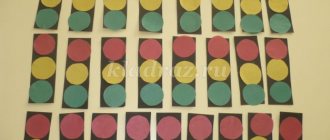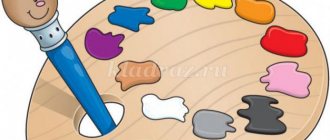Card file: Household work in the middle group card file (secondary group) on the topic
Card index: Household work in the middle group.
Card No. 1.
“Order in the closet with toys and manuals”
Goal: to teach children to independently and aesthetically arrange toys and aids, maintain order in closets, and wipe dust. Develop hard work and the ability to see disorder. To cultivate aesthetic taste and the desire to work for the benefit of others.
Card No. 2.
"Clean window sills"
Goal: to teach children to observe hygienic skills when working with water: roll up their sleeves, wet a cloth and wring it dry, rinse when dirty. Develop labor skills and habits, accuracy when working with water. Cultivate a desire to work in a team, in harmony.
Card number 3.
"Helping the nanny"
Goal: To teach how to make bed linen and to teach children to provide all possible assistance to adults. Develop hard work and a desire to help adults. Foster respect for the work of adults.
Card number 4.
"Dining duty"
Goal: independently and conscientiously perform the duties of a duty officer; wash your hands thoroughly, put on the clothes of the person on duty, set the table correctly, remove the dishes after eating; brush off tables and sweep the floor. Develop labor skills and abilities, the ability to see disorder in the table setting. Cultivate a desire to work for the benefit of others.
Card number 5.
"Class Duty"
Goal: independently and conscientiously perform the duties of an attendant: lay out materials and aids prepared by the teacher for the lesson on tables; wash and put them away after class. Develop hard work and a desire to help adults. Cultivate a desire to work for the benefit of others.
Card number 6.
"Order in toys"
Goal: to teach children to put on work aprons before starting work; keep toys in order: wash, dry, wipe and put in place. Develop hard work and the ability to see disorder; be careful when working with water. Cultivate a desire to work for the benefit of others.
Card number 7.
“Order in the dressing room closet (together with the assistant teacher)”
Goal: to teach children to maintain order in their personal wardrobes: empty the closet of clothes and shoes, wipe the shelves with a damp cloth, and neatly put the clothes back in place. Develop diligence, the ability to see disorder, and accuracy when working with water. Cultivate a desire to work in a team, in harmony.
Card number 8.
"Book Repair"
Goal: to teach children to peck at books, use glue and scissors correctly, and use napkins.
Develop labor skills, eye, fine motor skills, creative imagination. Foster a desire to work for the benefit of others, treat books and toys with care.
Card number 9.
"Clean chairs"
Goal: to teach children to help keep the chairs in the group room tidy and clean: wipe them with a damp cloth; arrange in places after classes. Develop labor skills and abilities, the ability to comply with cultural and hygienic requirements when working. Cultivate a desire to help adults and respect for their work.
Card number 10.
"Washing Doll Clothes"
Purpose: To teach children to help the teacher in washing doll clothes and bedding: to teach children to put on work aprons before starting work; prepare the necessary supplies for washing and drying, as well as a workplace; know how to use soap. Develop labor skills and abilities, the ability to comply with cultural and hygienic requirements when working. Cultivate a desire to work for the benefit of others.
Card number 11.
"Washing my combs"
Goal: To teach children to help the teacher in washing combs: rinse soaked combs, clean them with brushes. Develop diligence, the ability to see disorder, and accuracy when working with water.
Cultivate a desire to help adults and respect for their work.
Lesson summary "Organization of duty in the preparatory group"
Natasha Maralina
Lesson summary "Organization of duty in the preparatory group"
Goal: continue to teach children to independently perform the duties of a dining room attendant : setting the table.
Educational areas: "Labor"
, in integration with
“Cognition”
,
“Security”
,
“Communication”
.
Tasks:
Educational:
1) cultivate a positive attitude towards duty ;
2) to form in children responsibility for the assigned task.
Educational:
1) develop logic, memory, thought processes;
2) develop accuracy and the habit of labor effort.
Educational:
1) improve skills in performing sequential work actions in accordance with the task;
2) develop the ability to evaluate the results of your work.
Equipment: Napkin holders with napkins, bread bins, salad bowls, deep plates, small plates, glasses, forks, spoons, teaspoons for compote berries, trays.
Preliminary work: Conversation about table setting, designing a duty , introducing children to it, developing an algorithm diagram. D/i “What from the beginning, what then”
,
Educator: Who are we on duty in the dining room ?
Lera and Danila: We are on duty
Educator: Very good. Guys, guests came to us to see how you work. They want to see how well you are doing and write a note about your duty in our newspaper “Goroshinki”
. Do you want a note written about you and your parents read it?
The attendants agree.
Educator: Then you need to try to be on duty conscientiously , harmoniously and kindly towards each other. Agreed?
Attendants : Yes
Educator: Guys, how do you distribute the work?
Danila: We agree among ourselves.
Lera: Danila and I decided that I would put up napkin holders with napkins and bread bins. And Danila will lay out spoons and forks, and together we will lay out napkins, put glasses, plates and salad bowls.
Educator: Lera, tell me, what is table setting?
Lera: Table setting is the ability to set the table correctly, beautifully and tastefully.
Educator: In what order do we set the table?
Children answer
Danila: First you need to put napkin holders and bread bins on each table. Then lay down napkins.
Lera: Then put glasses, salad bowls, deep plates, spoons and forks.
Educator: Tell me, please, why do you need to be on duty ?
Answer from those on duty : To help Marina Yuryevna. We need to learn to help adults.
Educator: Marina Yuryevna will be very happy if you help her.
Marina Yuryevna expresses words of gratitude: “Yes, it’s easier to work with the help of those on duty. ”
.
Educator: Please, duty officers , begin your duties. ( The attendants wash their hands , put on aprons and hats)
.
The teacher observes the children's work activities. Children lay out cutlery.
The teacher conducts a conversation with the duty officers .
Educator: Who can tell me what the plate is for?
Danila: They put food on plates. We eat from them.
Lera: Bread bins are designed for bread. Soup, cabbage soup, beetroot soup, and rassolnik are poured into deep plates. Small plates are needed for main courses.
Educator: And what applies to them?
Lera: Second courses include meat, fish, sausages, cutlets; various side dishes: rice, vegetables, pasta, potatoes.
Educator: What are the glasses for?
Danila: Tea, milk, compote, jelly are poured into glasses.
Educator: On which side are spoons, knives, and forks laid out?
Danila: Spoons and knives are laid out on the right side, forks on the left.
The nanny comes from the catering department. The attendants help Marina Yuryevna distribute bread and put it in bread bins.
After preparing for lunch, those on duty sit down at the table to have lunch.
At this time, children come in from a walk: they undress, go wash their hands and sit down at the tables.
Educator: Children, bon appetit. (During a meal, the teacher praises the food, asks what the first dish was cooked from, recalls proverbs and sayings about food “Shchi and porridge are our food, etc.”
, riddles, if children do not eat well, then you can turn on the competitive aspect).
The attendants, having had lunch , take the trays and take the dishes away from their table.
The children eat first.
Educator: Children, I remind you that we eat the rest of the soup by tilting the plate away from us. When the children eat the first dish, the attendants take the plates on trays to the washing room, and there the assistant teacher, taking the empty plate, puts the second dish out for delivery. After lunch, the children thank them and take away the napkin and personal napkin they used to wipe their mouth. They go to rinse their mouth. The rest of the dishes are removed by the attendants . The plates are carried away on trays; glasses, napkin holders with napkins in hands.
Educator: Now, duty officers , what will you do?
Lera: First, we’ll sweep away all the crumbs from the tables, and then we’ll wipe the tables with a cloth.
Result:
Educator: Our duty guys did a great job , they tried very hard. They coped with their responsibilities and skillfully distributed the work.
Lera and Danila were on duty quickly and carefully. Thank you for being on duty . How pleasant it was for the children to sit down at such a beautiful, properly set table. No wonder they say: “The master’s work is afraid!”
.
File of work assignments for middle group students
Household work in the middle group.
Card No. 1 “Order in the closet with toys and manuals”
Goal: to teach children to independently and aesthetically arrange toys and aids, maintain order in closets, and wipe dust. Develop hard work and the ability to see disorder. To cultivate aesthetic taste and the desire to work for the benefit of others.
Card No. 2 “Clean window sills”
Goal: to teach children to observe hygienic skills when working with water: roll up their sleeves, wet a cloth and wring it dry, rinse when dirty. Develop labor skills and habits, accuracy when working with water. Cultivate a desire to work in a team, in harmony.
Card No. 3 “Helping the nanny”
Goal: To teach how to make bed linen and to teach children to provide all possible assistance to adults. Develop hard work and a desire to help adults. Foster respect for the work of adults.
Card No. 4 “Canteen duty”
Goal: independently and conscientiously perform the duties of a duty officer; wash your hands thoroughly, put on the clothes of the person on duty, set the table correctly, remove the dishes after eating; brush off tables and sweep the floor. Develop labor skills and abilities, the ability to see disorder in the table setting. Cultivate a desire to work for the benefit of others.
Card No. 5 “Duty for classes”
Goal: independently and conscientiously perform the duties of an attendant: lay out materials and aids prepared by the teacher for the lesson on tables; wash and put them away after class. Develop hard work and a desire to help adults. Cultivate a desire to work for the benefit of others.
Card No. 6 “Order in toys”
Goal: to teach children to put on work aprons before starting work; keep toys in order: wash, dry, wipe and put in place. Develop hard work and the ability to see disorder; be careful when working with water. Cultivate a desire to work for the benefit of others.
Card No. 7 “Order in the locker room closet (together with the teacher’s assistant)”
Goal: to teach children to maintain order in their personal wardrobes: empty the closet of clothes and shoes, wipe the shelves with a damp cloth, and neatly put the clothes back in place. Develop diligence, the ability to see disorder, and accuracy when working with water. Cultivate a desire to work in a team, in harmony.
Card No. 8 “Book Repair”
Goal: to teach children to peck at books, use glue and scissors correctly, and use napkins.
Develop labor skills, eye, fine motor skills, creative imagination. Foster a desire to work for the benefit of others, treat books and toys with care.
Card No. 9 “Clean chairs”
Goal: to teach children to help keep the chairs in the group room tidy and clean: wipe them with a damp cloth; arrange in places after classes. Develop labor skills and abilities, the ability to comply with cultural and hygienic requirements when working. Cultivate a desire to help adults and respect for their work.
Card No. 10 “Washing doll clothes”
Purpose: To teach children to help the teacher in washing doll clothes and bedding: to teach children to put on work aprons before starting work; prepare the necessary supplies for washing and drying, as well as a workplace; know how to use soap. Develop labor skills and abilities, the ability to comply with cultural and hygienic requirements when working. Cultivate a desire to work for the benefit of others.
Card No. 11 “Washing combs”
Goal: To teach children to help the teacher in washing combs: rinse soaked combs, clean them with brushes. Develop diligence, the ability to see disorder, and accuracy when working with water.
Cultivate a desire to help adults and respect for their work.
Card 12 “Learning to make our beds.”
Goal: To bring to the awareness of children how to properly make the bed; cultivate independence, accuracy, and the desire to help adults. Foster a responsible attitude towards self-care work and independence.
Card No. 13 “Helping the nanny in laying out bedding on the beds.”
Goal: To teach how to sort bed linen according to their belongings, to cultivate a desire to help the nanny and respect for other people’s work. Cultivate a desire to work, a sense of responsibility for the assigned work.
Card No. 14 “Changing dirty towels.”
Goal: Maintain a steady interest in work, the desire to diligently complete the assignment.
Card No. 15 “Washing chairs.”
Goal: to teach children to help the nanny, to keep the chairs in the group room tidy and clean: wipe them with a damp cloth; put in place. Develop labor skills and abilities, the ability to comply with cultural and hygienic requirements when working. Cultivate a desire to help adults and respect for their work.
Card No. 16 “Washing building materials.”
Purpose: To teach how to wash, dry and lay building materials, to teach children to constantly and promptly maintain order in the play area, to wash building materials with a soapy solution prepared by the teacher, to rinse and dry them; observe the rules of personal hygiene.
Card No. 17 “Washing dolls.”
Goal: To teach children to help the teacher in washing dolls: rinse soaked dolls, clean them with brushes. Develop diligence, the ability to see disorder, and accuracy when working with water. Cultivate a desire to help adults and respect for their work.
Card No. 18 “We wipe the dust off the shelves for games and toys.”
Goal: Continue teaching children to wipe dust from shelves with a damp cloth. Develop labor skills and abilities. To cultivate aesthetic taste and the desire to work for the benefit of others.
Card No. 19 “Creating order in the group.”
Goal: To form in children a conscious desire for order, the habit of putting away toys after playing. Improve the ability to draw up a work plan, select the necessary materials for upcoming activities
Card No. 20 “Order in toys”
Goal: to teach children to put on work aprons before starting work; keep toys in order: wash, dry, wipe and put in place. Develop hard work and the ability to see disorder; be careful when working with water. Cultivate respect for your own work and the work of others.
Card No. 21 “Washing napkins used for visual arts.”
Goal: to teach children the skills of soaping, rinsing and wringing out napkins, to continue to form a work culture (tidiness in the process of work).
Card No. 22 “Let’s check the pencils”
Goal: to strengthen children’s ability to put equipment for art activities in order. Train to carry out assignments diligently and accurately. Cultivate a love of work. The teacher gives instructions to check the boxes of pencils. All broken and scribbled and put on a tray for sharpening. Praises.
Card No. 23 “Let’s sharpen pencils”
Goal: to strengthen children’s ability to put equipment for art activities in order. Train to carry out assignments diligently and accurately. Cultivate a love of work. The teacher asks for help sharpening pencils. Shows how to do this using a sharpener. Praises children for their help.
Card No. 24 “Let’s clean the boards from plasticine”
Goal: to strengthen children’s ability to put in order equipment for modeling. Cultivate accuracy and a desire to work.
The teacher explains how to wipe the board with a cloth, applying a little force
Card No. 25 “Cut napkins”
Goal: Continue to teach how to hold and use scissors correctly. Foster a positive attitude towards work and a desire to help adults.
The teacher asks for help cutting napkins. Shows how to do this: take a napkin and carefully, from the fold side, cut off a thin strip, also from the side where there are two folds. As a result, we get 4 small square napkins, which we put in a napkin holder.
Card No. 26 “Washing pallets of flowers”
Goal: to teach children to observe hygienic skills when working with water: roll up their sleeves, wet a cloth and wring it dry, rinse when dirty. Develop labor skills and habits, accuracy when working with water. Cultivate a desire to work. Learn to follow safety and personal hygiene rules.
Card No. 27 “Watering indoor plants.”
Purpose: To give children an idea of the methods of watering (in a tray, under the leaves) and the rules (do not flood, water evenly); cultivate a desire to care for plants. Invite children to help as much as possible, clarify children’s ideas about indoor plants.
Card No. 28 “Caring for large-leaved plants.”
Purpose: To teach children to wipe large plant leaves with a damp cloth, being careful. Give children the knowledge that this method of care makes it easier for plants to breathe, which determines their growth and development. Develop labor skills and habits, accuracy when working with water and plants. Foster an ecological culture, a caring attitude towards the natural environment, and a desire to take care of it.
Card No. 29 “Spraying indoor plants with water from a spray bottle.”
Goal: To teach a new work skill; reinforce children’s understanding that leaves also need moisture; cultivate a caring attitude towards plants. Teach children how to use the sprayer correctly. Develop labor skills and habits, accuracy when working with water and plants. Foster an ecological culture, a caring attitude towards the natural environment, and a desire to take care of it.
Card No. 30 “Green landing on indoor plants”
(remove diseased leaves, fertilize).
Goal: To teach children to determine by the condition of indoor plants what actions are necessary to care for them (watering, cleaning, loosening, fertilizing, correctly perform the relevant labor operations, invite the children to tell about the purpose of each of them.
Card No. 31 “Loosening the soil of indoor plants.”
Goal: Teach children to care for indoor plants; give children knowledge about why it is necessary to loosen the soil of plants; consolidate loosening techniques and rules for using the necessary items for this. Develop labor skills, accuracy. Foster an ecological culture and respect for the environment.
Card No. 32 “Planting onions.”
Goal: To teach children to set a goal, prepare a workplace, tools and clean up after themselves. To consolidate children's knowledge about the structure of the onion and the conditions necessary for onion growth. Develop labor skills and habits, accuracy when working with land, water and plants. Foster an environmental culture, a desire to achieve results, and participate in a common cause.
Card No. 33 “Sowing seeds of flowers and vegetables.”
Goal: To give children knowledge that every plant has seeds. Learn the sequence of actions required when sowing seeds; make a hole in the ground (for sowing seeds, each time marking with a stick the distance between them and the grooves for small seeds; teach to observe cultural and hygienic skills when working. Consolidate children’s knowledge about what time, what seeds are sown in boxes in the group for preparation seedlings, and which seeds are sown in open ground. Develop labor skills and abilities. Foster an ecological culture, respect for the surrounding nature, and a desire to take care of it.
Card No. 34 “Planting seedlings, caring for them.”
Goal: To form children’s ideas about the main stages of plant growth and development (seed, seedling, stem with leaves); about the basic methods of growing plants and caring for them (planting in loose soil, watering, loosening the soil, weeding, feeding). Be careful when planting seedlings, as the plants are very fragile. Develop labor skills and habits, accuracy when working with land, water and plants. Foster an ecological culture, a caring attitude towards the natural environment, and a desire to take care of it.
Card No. 35 “Caring for plant leaves” (removing dust with a brush and a dry cloth)
Goal: To teach children to remove dust from plants with brushes or dry cloths, being careful. Determine for which plants this method of dust removal is suitable (hairy leaves of geranium, violet, etc.) Give children knowledge that this method of care makes it easier for plants to breathe, which determines their growth and development. Develop labor skills and habits, accuracy when working with water and plants. Foster an ecological culture, a caring attitude towards the natural environment, and a desire to take care of it.





